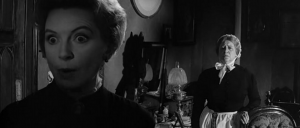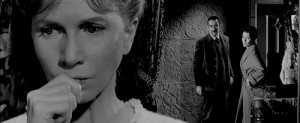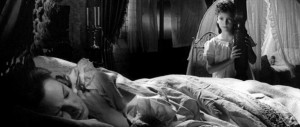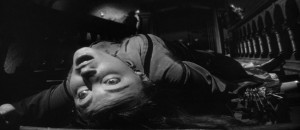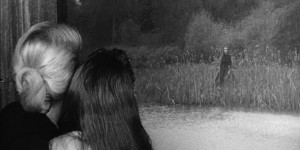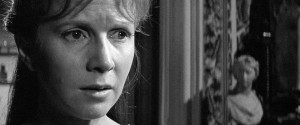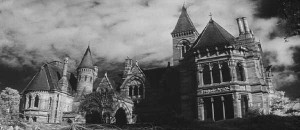Written in November 2014 for my February 2015 “En movimiento” column in Caimán Cuadernos de Cine. Given the precipitous decline in Truman Capote’s literary reputation since his death, it seems a pity that he’s better known as a screenwriter on the overrated Beat the Devil than on The Innocents, a far more durable though far less celebrated work. — J.R.
Bonus features are an important part of digital film culture, and one shortcoming is the attention usually accorded to both literary and cinematic sources. While these sources aren’t necessarily ignored, they’re rarely emphasized, so that younger viewers watching, for the first time, Jack Clayton’s The Innocents (1961) and Robert Wise’s The Haunting (1963) –- two exceptionally literate and intelligent horror films, both beautifully and resourcefully filmed in black and white CinemaScope -– are apt to overlook the fact that they’re adapted quite faithfully from what Stephen King has called the two “great novels of the supernatural in the last hundred years,” namely Henry James’ The Turn of the Screw (1898) and Shirley Jackson’s The Haunting of Hill House (1959). Though both novels are cited and discussed in the extras (and Truman Capote’s contribution of Southern Gothic elements to the screenplay for The Innocents is rightly applauded), they’re rarely accorded the attention they deserve. And when it comes to these films’ cinematic sources, the key name of Val Lewton gets mentioned only belatedly and briefly by Wise and then by his screenwriter, Nelson Gidding, in the audio commentary on the Warners Blu-Ray. (Wise, after all, was given his start as a director by Lewton on his first three features, Curse of the Cat People, Mademoiselle Fifi, and The Body Snatchers.)

There’s been some belated recognition of Lewton as a master-producer of low-budget horror films in the 1940s in which unseen horrors commonly take precedence over what’s seen — most notably in the three Lewton films directed by Tourneur (Cat People, I Walked with a Zombie, The Leopard Man) and a few more (especially The Seventh Victim) directed by others. But apart from a few cases where Lewton’s influence becomes too obvious to ignore (e.g., Tourneur’s 1957 masterpiece Night of the Demon), the relatively genteel, literary, and gore-free horror films that depend mainly on suggestion, mood, and psychological undercurrents are rarely labeled as Lewtonesque. Similarly, the separate critical communities associated with literature and film rarely communicate with each other, so that the two adjectives that seem most appropriate — Jamesian and Lewtonian for The Innocents, Jacksonian and Lewtonian for The Haunting — are seldom employed.
Stylistically, neither of these films qualifies as a strict imitation of Lewton: The Innocents is too English and pictorial, The Haunting too bombastic and baroque (with Wise’s editing skills fully apparent, along with many low and tilted angles, abrupt camera movements, and a barrage of sound effects). But both are still remarkable examples of applied Lewtonesque principles in which psychological disturbances are deftly crossed with supernatural disturbances to the point where we can’t readily separate the two, and our imaginations do the rest. The parallels between these films and between their literary sources — Jackson’s novel being inspired in part by James’, and both featuring the viewpoints of disturbed and sexually repressed single women — are highly suggestive. Both films manage to preserve some of the more “daring” elements of their sources (pedophilia in James, a lesbian character in Jackson), and it’s worth noting that Jackson, who came up with the title The Haunting, was delighted with the film when she saw it.
One of the smartest reviews Pauline Kael ever wrote was of The Innocents –- included in her first collection, I Lost It At the Movies, but omitted in both her swan-song compendium For Keeps and Sanford Schwartz’s The Age of Movies: Selected Writings of Pauline Kael (surely the most useless of all of Library of America’s “canonical” collections of film criticism). Rereading Kael’s appreciation after looking at the BFI’s excellent DVD (with a fine, detailed introduction by Christopher Frayling), I liked the film and Kael’s review more than I did over a half a century earlier. Having read more of James in the interim, I particularly value the review as a discerning piece of literary criticism as well as a solid assessment of the film’s strengths (especially Deborah Kerr’s performance), so my only regret about the BFI package is that this review wasn’t reprinted in the accompanying booklet. But even here, Lewton goes unmentioned. And Kael’s detailed and sympathetic treatment of The Haunting (also in I Lost It At the Movies), which fails to allude to either Jackson’s novel or to Lewton, is hampered by reviewing the unsympathetic audience she saw it with more than the film itself.

